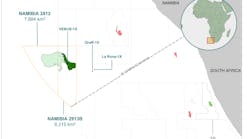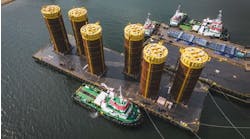View Article as Single page
Case studies
Such a project management philosophy was instrumental in the planning and executing of a liner drilling operation in the UK sector of the North Sea. The reservoir conditions for this well included a complex lithology consisting of two unstable cap rock formations, shales, depleted sands, and clay stones in which wellbore swelling and stuck pipe events were highly probable with conventional drilling. In addition, the presence of a fault at a depth of 16,775 ft (5,113 m) raised the risk of complete lost circulation, without the opportunity to drill another section below. These risks prompted the operator to seriously consider P&A the well.
As an alternative, the operator approached the possibility of deploying liner drilling to drill through the trouble zones and get the well to total depth. Because the operator was working on a very tight timetable, the liner drilling solution had to be developed and deployed within a two-week window.
A project management team of UK-based personnel from both the operator and the service company, as well as a Houston-based subject matter expert and support personnel met regularly via conference calls to analyze the well and develop the necessary liner drilling equipment and process. The team settled on a simple liner drilling assembly consisting of a liner setting sleeve, Type I landing collar, float collar, and EZCase casing drill shoe.
To minimize fluid loss while drilling, the "smear effect" or "plastering effect" was considered. This theory is based on the solids created during the drilling operation that are ground into smaller more homogeneous solids, and are then plugged into the narrow lost circulation zones as they travel up the wellbore. No pressure control or lost circulation events were recorded during drilling, which indicated that the combined effect of plastering, stress cage, and MPD technology in the drilling mud worked as planned.
In addition, rotating the liner during drilling likely resulted in the "smear effect," in which the cuttings were pulverized in the narrow annular space as they traveled up the well. These particles become embedded in, or smeared against, the wellbore wall to form an impermeable seal that prevents loss of drilling fluids to the formation.
Additionally, the team used engineering services to develop a drilling mud that incorporated additives to prop open and seal any fractures (per the so-called "stress cage" effect). The team also decided to deploy managed pressure drilling (MPD) techniques through these trouble zones as an additional pressure control and fluid loss mitigation measure.
The next step was to develop a high-efficiency, low-risk liner drilling running procedure. A number of drilling simulations were conducted using actual field data to see how changes to drilling rotation, rate of penetration, fluid circulation rates/pressure, and mud density would impact the safety and reliability of the liner drilling operation.
The next step was to assemble the necessary equipment for the job. The right people were needed on location to perform the job in a short time period. This required combining local expertise in drilling engineering with support from Houston-based subject matter experts. This was accomplished using the service provider's BEACON real-time collaboration centers, which allowed for remote monitoring, support, and control.
With the drilling plan in place and with the collaboration center providing real-time monitoring and communication, liner drilling commenced. A total of 225 ft (69 m) was drilled with liner through the clay stone, shale, depleted sand and two-cap rock seals, and the well reached the planned TD of 16,864 ft (5,140 m) without incident in two days.
Ultimately, liner drilling saved the operator on its well costs and delivered a productive well that would otherwise have been abandoned.
Careful planning was also critical for a liner drilling job in a highly deviated well offshore Mexico. The operator was expecting total lost circulation at a window located at 2,600 ft (800 m) MD while drilling at a 64° deviation. The total length of liner required was 8,860 ft (2,700 m), making this one of the longest liner drilling jobs to date.
The operator and service provider worked together to develop the drilling plan, which consisted of running a 7-in. expandable liner hanger with a liner-mounted drill bit. To minimize lost circulation in the window, an oil-base mud was used.
The system demonstrated high torque capabilities and a better bypass area, combined with a bit that efficiently drilled through the trouble zone. While the original liner drilling target length was 66 ft (20 m), the system drilled 243 ft (74 m), all while maintaining the required 64° angle.
Drilling went according to plan, allowing the operator to reach total depth with no NPT, no fishing or stuck pipe events, and with minimal fluid losses. The operator was able to maintain the planned well deviation and drill this record-setting liner drilling job in one trip. During this job, neither MPD nor seal particles were used, proving that the plastering effect alone helped to mitigate mud loss as a solution for trouble zone solutions.
These are two examples of successful stories realized with liner drilling systems in offshore wells around the world. As wells go deeper and new reservoir challenges arise, the same careful collaborative approach to liner drilling planning and execution will likely lead to similar success.


